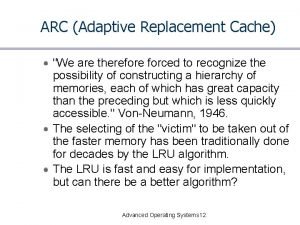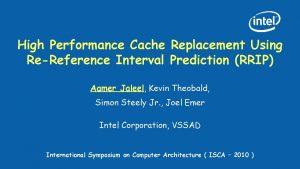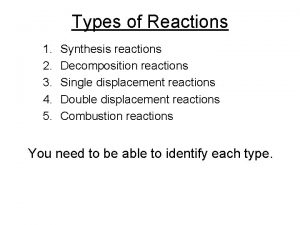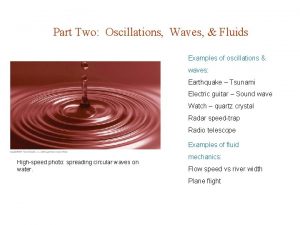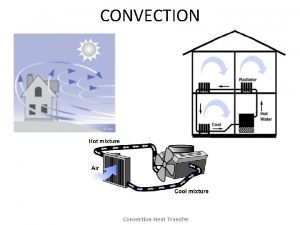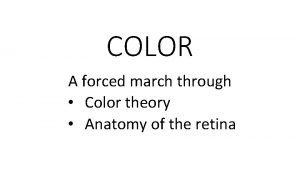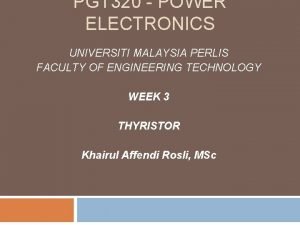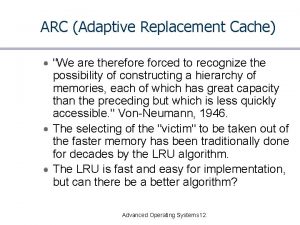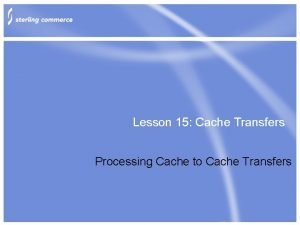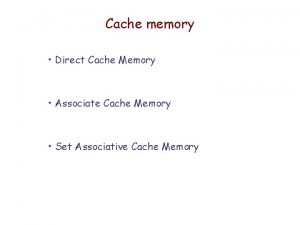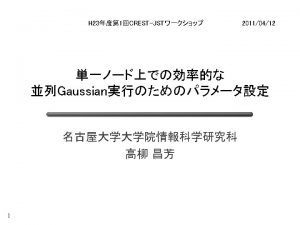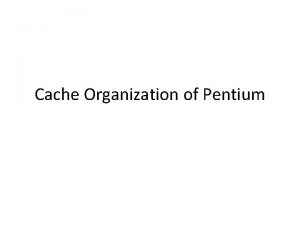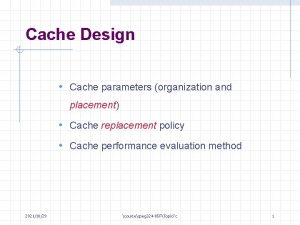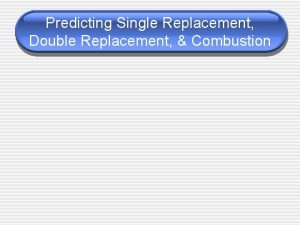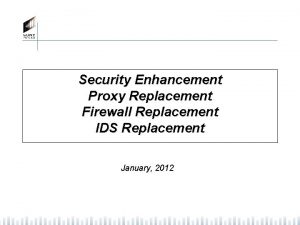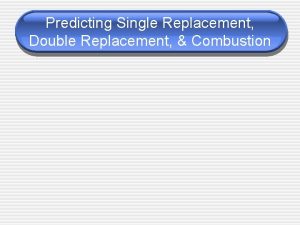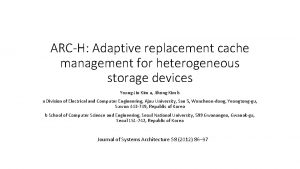ARC Adaptive Replacement Cache We are therefore forced























- Slides: 23

ARC (Adaptive Replacement Cache) "We are therefore forced to recognize the possibility of constructing a hierarchy of memories, each of which has great capacity than the preceding but which is less quickly accessible. " Von-Neumann, 1946. The selecting of the "victim" to be taken out of the faster memory has been traditionally done for decades by the LRU algorithm. The LRU is fast and easy for implementation, but can there be a better algorithm? Advanced Operating Systems 12.

Motivation The LRU is employed by: – – – – RAM/Cache Management Paging/Segmenting systems Web browsers and Web Proxies Middleware RAID Controller and regular Disk Drivers Databases Data Compression (e. g. LZW) Many other applications ARC was suggested by N. Megiddo and D. Modha of IBM Almaden Research center, San Jose, CA on 2003 and is better than LRU. Advanced Operating Systems 22.

LRU complexity LRU is implemented by a double linked list. When a page in the list is accessed, it will be moved from its place to the end of the list. When a new page is accessed, it will be put in the end of the list and the oldest page is taken out of the list. Both of the operation are of an O(1) complexity. removing pointer oldest adding pointer newest Advanced Operating Systems 32.

LRU disadvantages The fundamental locality principle claims that if a process visits a location in the memory, it will probably revisit the location and its neighborhood soon. The advanced locality principle claims that the probability of a revisiting will be increased if the number of the visits is bigger. LRU supports just the fundamental locality principle. What will happen if a process scans a huge database? Advanced Operating Systems 42.

LFU replaces the least frequently used pages. LFU takes into account the advanced locality principle and a scan of a huge database will not be a trouble, HOWEVER… LFU is implemented by a heap; hence it has a logarithmic complexity for adding or removing a page from the heap and also for updating a place of a page in the heap. Stale pages can remain a long time in the memory, while "hot" pages can be mistakenly taken out. Advanced Operating Systems 52.

LRU vs. LFU LRU was suggested on 1965 and LFU on 1971. The logarithmic complexity of LFU was the main reason for its impracticability. LFU had a periodic check for the stale pages. – This solved the stale pages problem. – But, it made the performance even worse. LRU beat LFU; thus, LFU has been pushed into a corner, until 1993, when O'Neil revisits LFU in order to develop the LRU-K technique. Advanced Operating Systems 62.

LRU-K memorizes the times for each cache page's k most recent references and replaces the page with the least kth most recent references. If there is no kth reference, LRU-K will consider the reference to be infinite (The oldest). LRU-K retains a history of references for pages that are not currently present in the memory. Advanced Operating Systems 72.

LRU-K Pro. & Con. When a page is referenced, it will typically not be moved to the end of the list; hence a linked list cannot be good for the implementation and a heap is needed logarithmic complexity. Scanning a huge database will not be a trouble like with LFU, but LRU-K outperforms LFU, because stale pages are handled better. LRU-K maintains the advanced locality model, but did not succeed to beat LRU because of the complexity. Advanced Operating Systems 82.

2 Q On 1994 Johnson & Shasha suggested an improvement to LRU-2. 2 Q has two queues A 1 and Am: – On the first reference to a page, 2 Q places the page in the A 1 queue. – If a page is accessed again when it is in A 1 or Am queues, the page will be moved to the end of Am queue. – The sizes of A 1 and Am are constants (e. g. 20% of the cache for A 1 and 80% for Am). When a new page is added to one of the queues, an old page from the same queue will be removed if need. Advanced Operating Systems 92.

2 Q Pro. & Con. 2 Q is implemented by linked lists O(1) complexity. 2 Q has just two queues; thus it just partially adapts the advanced locality model. The execution time of 2 Q is about 25% longer than LRU, but it gives 5%-10% better hit ratio. These results were not convincing enough. Advanced Operating Systems 102.

The Clock Algorithm The memory spaces holding the pages can be regarded as a circular buffer and the replacement algorithm cycles through the pages in the circular buffer, like the hand of a clock. Each page is associated with a bit, called reference bit, which is set by hardware whenever the page is accessed. Advanced Operating Systems 112.

Choosing victims by Clock When it is necessary to replace a page to service a page fault, the page pointed to by the hand is checked. – If its reference bit is unset, the page is replaced. – Otherwise, the algorithm resets its reference bit and keeps moving the hand to the next page. Linux and Windows employ Clock. Advanced Operating Systems 122.

LRFU On 2001 Lee at el. suggested a combined algorithm of LRU and LFU named LRFU can be tuned to be close to LRU or be close to LFU. LRFU's clock is expressed by the number of the pages that have been accessed. I. e. the time is incremented by one on each page reference. Advanced Operating Systems 132.

Combined Recency and Frequency Let us define Combined Recency and Frequency (CRF) as: where – – – tc is the current time. b is the block id. tbi is the ith time that block b has been referenced. F(x) is the function 2 - x. k is the number of the times that the block has been referenced. Advanced Operating Systems 142.

The F(x) function When LRFU has to take a page out of the memory, it will choose the page with the minimal CRF. If F(x) is a constant for any x, LRFU will exactly act like LFU; hence if is set to 0, LRFU will be LFU. If F(x) holds for any i and any k where k i+1, LRFU will exactly act like LRU; hence if is set to 1, LRFU will be LRU. Advanced Operating Systems 152.

LRFU Performance According to experimental results, is usually set to a very small numbers less than 0. 001. – This means LRFU is LFU with a slight touch of LRU. LRFU outperforms LRU, LFU, LRU-K and 2 Q in hit rate. The pages are kept in a heap; hence the complexity of LRFU is O(log(n)). Advanced Operating Systems 162.

ARC Definitions Let c be the number of pages in the memory. L 1 and L 2 are two linked lists. L 1 contains the pages that have been accessed just once, while L 2 contains the pages that have been accessed at least twice. The allowed operations on L 1 and L 2 are the same operations that are allowed on an LRU linked list. Advanced Operating Systems 172.

ARC Policy 0 |L 1|+|L 2| 2 c 0 |L 1| c , L 2 can be bigger than c. When a page is accessed; if the page is in L 1 L 2, move it to the MRU of L 2; otherwise move it to the MRU of L 1. If adding the new page makes |L 1|+|L 2| >2 c or |L 1|>c; if L 1 (before the addition) contains less than c pages, take out the LRU of L 2; otherwise take out the LRU of L 1. Advanced Operating Systems 182.

Lists' Partitions |L 1|+|L 2| 2 c, but the size of the memory is just c. Let T 1 be the most recent pages in the memory and B 1 be the least recent pages in the memory. Similarly, L 2 is partitioned into T 2 and B 2. T 1 T 2 contains the pages that are actually in the memory. Advanced Operating Systems 192.

Which page is taken out When a page is moved from a "T" list to a "B" list, it will be taken out of the memory. Let p be the current target size for the list T 1. If |T 1|>p, move the LRU of T 1 to be the MRU of B 1. If |T 1|<p, move the LRU of T 2 to be the MRU of B 2. If |T 1|=p, – If the accessed page has been in B 2, move the LRU of T 1 to be the MRU of B 1. (Because p is going to be decremented). – If the accessed page has been in B 1 or has not been in the memory, move the LRU of T 2 to be the MRU of B 2. Advanced Operating Systems 202.

Setting P If there is a hit in T 1 or T 2, do nothing. If there is a hit in B 1 – If the size of B 1 is at least the size of B 2, increment p by 1; otherwise, increment p by |B 2|/|B 1|. If there is a hit in B 2 – If the size of B 2 is at least the size of B 1, decrement p by 1; otherwise, decrement p by |B 1|/|B 2|. The increments and the decrements are subject to the stipulation 0 p c The idea is to "invest" in the list that is performing the best. Advanced Operating Systems 212.

ARC Advantages When scanning a huge database, there are no hits; hence p will not be modified and the pages in T 2, will remain in the memory Better than LRU. Stale pages do not remain in the memory Better than LFU. ARC is about 10%-15% more time consuming than LRU, but the hit ratio is in average about as twice as LRU. Low space overhead for the "B" lists. Advanced Operating Systems 222.

Conclusions ARC captures both "recency" and "frequency". ARC was first introduced at 2003, but the journal paper was published at 2004. Folklore holds that Operating Systems has 3 principles: – Hash, Cache and Trash. • ARC improves the caching; hence so significant. Advanced Operating Systems 232.
 Adaptive replacement cache
Adaptive replacement cache Arc: a self-tuning, low overhead replacement cache
Arc: a self-tuning, low overhead replacement cache Mikael ferm
Mikael ferm Rrip cache replacement policy
Rrip cache replacement policy Cache replacement championship
Cache replacement championship Combustion reaction formula
Combustion reaction formula Parts of a circle
Parts of a circle What is the arc
What is the arc Arc emu88 com arc info 37 100037 html
Arc emu88 com arc info 37 100037 html Arc promoteur vs arc investigateur
Arc promoteur vs arc investigateur Muscles involved in expiration
Muscles involved in expiration Forced oscillation
Forced oscillation Forced control
Forced control Disadvantages of short tube evaporator
Disadvantages of short tube evaporator What was bela katz forced to do
What was bela katz forced to do Worth four dot test
Worth four dot test Convection formula
Convection formula Standard vertical tube evaporator
Standard vertical tube evaporator Forced-colors
Forced-colors Messenian person forced to work as a lowly farmer by sparta
Messenian person forced to work as a lowly farmer by sparta The plains indians were finally forced to surrender
The plains indians were finally forced to surrender Forced vibration and resonance
Forced vibration and resonance Scr protection
Scr protection Respon
Respon
